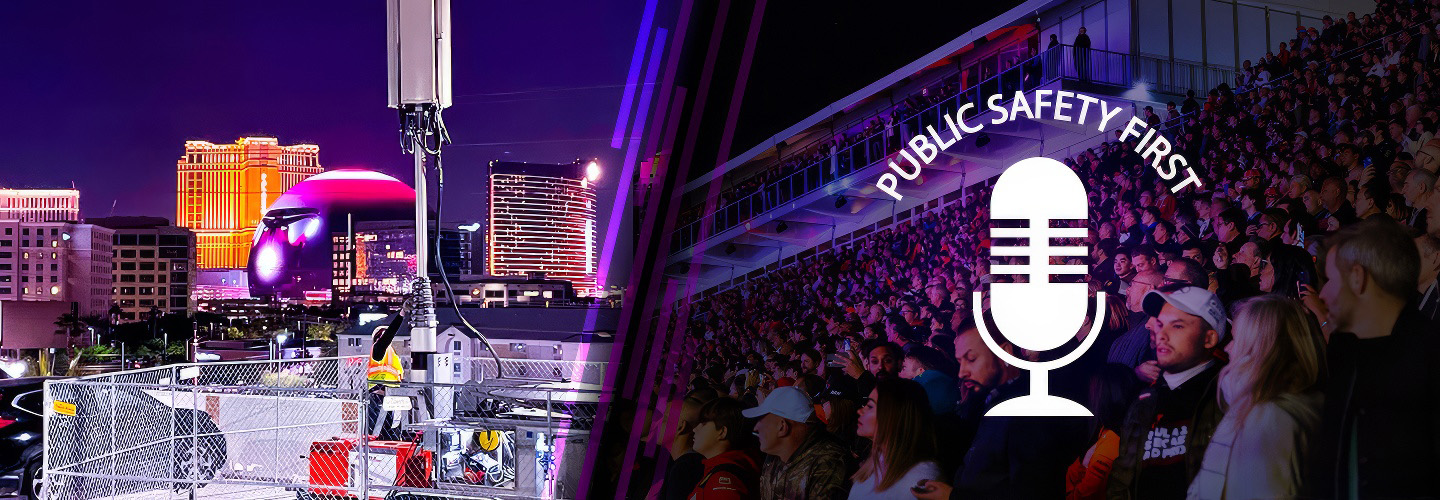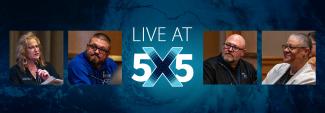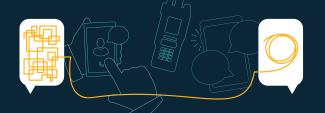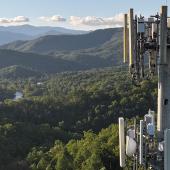Summary
Guest
Doug Harder, Senior Public Safety Advisor, First Responder Network Authority
Brian O’Neal, Assistant Chief, Clark County Fire Department, Nevada
Transcript
Preview
Episode 77: FirstNet powers Las Vegas Public Safety at the Big Game and F1 Grand Prix
Narrator: You're listening to Public Safety First, a podcast to help you learn about the First Responder Network Authority and how you can be part of the future of public safety technology.
And now, your host.
Episode 77: FirstNet powers Las Vegas Public Safety at the Big Game and F1 Grand Prix
Narrator: You're listening to Public Safety First, a podcast to help you learn about the First Responder Network Authority and how you can be part of the future of public safety technology.
And now, your host.
Doug Harder: Welcome to the podcast. I'm Doug Harder, Senior Public Safety Advisor with the FirstNet Authority in the Stakeholder Collaboration Division. Today, I'm honored to be joined by Clark County's Assistant Fire Chief, Brian O’Neal. I had the pleasure of working closely with Chief O’Neal for the better part of a year now on pre-planning for both the F1 Race and the 2024 Super Bowl in Las Vegas, Nevada. I'm so honored to have you on the podcast today. Thanks for joining, Chief.
Assistant Chief Brian O’Neal: Hey. Good morning. Happy to be here.
Doug Harder: Real quick, just to start off, Chief O’Neal, if you could tell us a little bit about yourself and Clark County Fire.
Assistant Chief Brian O’Neal: Sure. My name is Brian O’Neal. I'm an Assistant Chief with Clark County Fire. I've been here for 22 years. I've worked through various ranks with the fire department. I started out as a firefighter, spent a couple years as an engineer driving fire trucks. I got to spend the majority of my career as a captain and worked at many of the busiest stations on the strip and then promoted a couple years ago to Assistant Chief. Throughout that whole time, I've been a paramedic as well. And really love the medicine side of what we do in fire.
And then for Clark County Fire Department [CCFD], we are an all-hazards fire department in Las Vegas. So, most of what the majority of the public considers to be Las Vegas is protected by Clark County. We have the Las Vegas strip from Sahara and everything south, which includes all the big hotels on the strip. We also cover down to Laughlin and the California state line. And we have a station in Jean. We have a total of five battalions that are that are covered by 32 stations, and we have 740 personnel in suppression. We also are a combination department, and we have ten volunteer fire stations in the outlying areas and approximately 100 volunteer firefighters. We run about 160,000 calls a year.
Doug Harder: Excellent. That's a big department. Can you talk to us a little bit about how the fire department uses FirstNet on a daily basis?
Assistant Chief Brian O’Neal: We are a big department. We're spread out, we're diverse. We respond into all types of businesses and buildings and high rises. We do use FirstNet in a lot of our communication infrastructure. So, the majority of our cellular devices are on FirstNet. The daily communication between troops in the field, between their supervisors and then the command staff and the administrative staff of the department. We also use some tracking technology that relies on our cellular networks. We use that for accountability of resources that are deployed to incidents. And so, we track the larger event footprint between our stakeholders, which could be from law enforcement or from private ambulance, transport companies, and then our fire department assets that are supporting those incidents or those events.
Doug Harder: Excellent. So, before we get into talking about the planning effort and the support for the Super Bowl and the F1 race this year, I wanted to just give a quick overview of a program here at the FirstNet Authority. It's called the Network Experience and Engagement Program, or NEEP. And through that program, we help public safety agencies operationalize broadband. Specifically, we do this through pre-planning support, post event reviews, training and exercise assistance. We've helped public safety officials with pre-planning for all sorts of events, including the Waste Management Phoenix Open, the World's End Ultramarathon, the Grundy County Illinois Corn Festival, and many other events, large and small. Specifically for the Super Bowl, we've conducted pre-planning engagements with agencies for the last six Super Bowls, starting in Atlanta, Georgia. Pre-planning is a key information gathering initiative for any planned event. During the pre-planning process, we work with public safety to determine and document where responders will be operating during the event, what broadband capabilities they plan to use during the event, and what types of technologies they'll need. Throughout this process, we work very closely with the AT&T FirstNet Response Operations Group [ROG]. They are with us side by side at the planning meetings, and from the information we're able to gather at these meetings, the ROG team drives the solutions that are put in place during the event.
Specifically for Las Vegas, Chief, the F1 race was huge, the Super Bowl was huge. You had two major events in Las Vegas pretty much back-to-back, bringing in thousands of fans and spectators. For these two events, can you describe what was involved in preparing for these major events, especially when they were so close to each other timing-wise, but very different in scope and requirements?
Assistant Chief Brian O’Neal: We probably started about seven months or so pre-event, for both of these. And that started with just a really honest assessment of what the network coverage is. Like you said, the two events are completely different. The F1 is a six-mile loop over streets that are being used every day. And a really a broad area that would eventually be lined with grandstands and have 100,000 people spread out over that whole track. And then the Super Bowl, you know, obviously everyone saw Allegiant Stadium and how great of a venue that is to see a game. But, the Super Bowl actually has just dozens of small events that are set up all around the city that entire week. And so, we really had to have a really honest look at what the coverage is. And we reached out to all the providers to provide maps and help us identify where any gaps were and then look at what we could do to supplement the coverage that was already there, knowing that the demand for it that's here on a random Monday isn't going to be the same as it will be on race day or on game day. And so how can we build the capacity within that system to accommodate all those different people?
So, you know, FirstNet was a really good partner in that. They provided everything that we were looking for, which is what is the coverage like? How many people will this be able to accommodate? How can we bring in more assets to make it more robust? How do we plan for if it isn't able to meet that capacity? If the system fails, how do we maintain our public safety infrastructure, and how do we make sure that our systems are still going to operate effectively? And so, that involved a lot of redundancy and resiliency within that network. And a lot of the solutions that the Response Operations Group was able to provide with CRDs [Compact Rapid Deployables], SatCOLTs [satellite cell on light trucks], the hotspots — they suggested all of those solutions for us, and we implemented pretty much every piece of it.
Doug Harder: Excellent. You said that you started about seven months before the events. What was the cadence of the meetings that you held?
Assistant Chief Brian O’Neal: It was frequent. We did them every two weeks. Obviously, as we got closer, they became a little less long because most of the questions we already had answers to. But, we started this every two weeks. We had a lot of information to cover. You know, I'm not an expert in this field by any stretch. So, there was a lot of education and training to get us through the finish line on some of these things, literally. And FirstNet is a great partner in that way, is that they're educating as they go. And so we were consistent, we continued to meet every two weeks until we felt really comfortable with where we were.
Doug Harder: Great. Can you just tell us kind of an overview, a number of how many public safety agencies were actually involved in these two events, and why is the interoperability between them so important?
Assistant Chief Brian O’Neal: So, we have a number of different agencies here in the Valley. We already are fairly big, and we do have big events pretty frequently here. But, there is a number of fire departments that are involved. There's a number of private ambulance companies that are involved. We don't typically transport here on CCFD, so we have to rely on a whole medical branch that's supported mainly for us with these events by community ambulance. And so, we need that relationship to be successful. We also have all of our law enforcement partners that provide the bulk of the security and prevention aspects of preparation. Las Vegas Metropolitan Police Department is the biggest. But, nobody can staff these by themselves. And so, we're pulling in, highway patrol, school police, other jurisdictional police departments. As we get into the Super Bowl and the high seer rating that the Super Bowl has, now all of a sudden we're bringing in all these federal partners, like the FirstNet Authority, to support our incidents.
Doug Harder: Absolutely. And so, through that pre-planning effort with the Super Bowl, can you talk a little bit about how the FirstNet Authority and the AT&T FirstNet ROG, the Response Operations Group team, supported you during these efforts?
Assistant Chief Brian O’Neal: Sure. So, one of the big things was that it's relationship building from the start. We have regular meetings and we started months ahead of time. But, it's also developing trust and commitment from each other that we're going to be able to provide the help when we need it. We actually did have two unplanned incidents during the work up to these events. We had a significant flash flooding event on Mount Charleston and the week of the Super Bowl, we had an avalanche because we had another atmospheric river come through and dump like three feet of snow in one night up on Mount Charleston also. So, we did have assets that we were able to support the unplanned stuff. And that just goes to the commitment and the relationship building. But, specifically for the Super Bowl and F1, we did a lot of, kind of, resiliency within our building here. We built our own resilient channels that are broadcasting FirstNet. We do have a tower that's nearby, but it's been vandalized. Our station here is in downtown Las Vegas, just off the strip on Flamingo. We didn't feel like it was going to be reliable. FirstNet actually came in and built our own system that can broadcast the FirstNet Network here in the building. They also provided SatCOLTs that were able to be distributed around the event footprint, so that we made sure that our network was going to be really robust and have the capacity.
We had a dog come in to support the MACC [multi-agency coordination center] stand up in support of the Super Bowl. We deployed miniCRDs as a emergency backup plan if the system went down. They’re satellite connected, so we were able to set up just a mini network based on satellite. And that was part of our PACE [Primary, Alternate, Contingency, Emergency] planning of making sure that we had contingency plans and emergency plans in place for our communications that wouldn't suffer. You know, I think all of the various assets that FirstNet can bring to an event, we were able to deploy them.
Doug Harder: You mentioned ROG the dog. ROG the dog is a hit wherever you go.
Assistant Chief Brian O’Neal: Yes. Absolutely.
Doug Harder: So, throughout that pre-planning process, in your opinion, what were the most useful pieces of it working with FirstNet, the FirstNet Authority and the AT&T team?
Assistant Chief Brian O’Neal: I think really the most useful, again, because this isn't our field, you know, I put fires out, I drag hoses across the ground. I treat people that are sick. So the most useful piece is the education, the understanding what capabilities you have and how we can deploy them and how we can ensure that this is a no fail environment, right? Where any contingency is already provided for. And, we have 100% trust that the network is going to be reliable for us.
Doug Harder: You mentioned the snow and the avalanche up at Mount Charleston. Can you talk just a little bit about, kind of, what your needs were and how the ROG team transitioned from an event to supporting an incident and then coming back to the event again?
Assistant Chief Brian O’Neal: Yeah. Mount Charleston is a mountain community. It's about 45 minutes to the northwest of Las Vegas. It's up above 7,000 feet. It does get quite a bit of snow. There is a ski lift, and there's winter recreation that goes on up there. There are a number of full-time residents and a number of vacation properties, but, it's one of our more susceptible communities to natural disaster. Right. Las Vegas is fairly stable in that way. We don't have a ton of threats to our community, but that's definitely one of them that gets affected by the weather. And it does consistently. I think we're the only Super Bowl city that's had an avalanche the week of the Super Bowl.
Doug Harder: You are correct.
Assistant Chief Brian O’Neal: Which I do love to claim that. But, when they have weather up there, they lose power. And when they lose power, they lose their cellular coverage. It's already fairly shaky to begin with just because of the way the box canyons are laid out and the community is kind of spread up into the mountains. And so, the communication challenges that are there are very real. The responders have trouble communicating with each other. The radio systems don't work great. The cellular coverage is not great. And communication is one of the most important things that we have, if not the most important.
And so, when those occurred, we did send up the SatCOLT up to the lodge for the flash flooding event. And that was our command post. We did deploy an incident management team to Mount Charleston. They operated out of that lodge. They were supported with the SatCOLT when the avalanche occurred, which is in the next canyon over in Lee Canyon. The FirstNet team was able to supply a CRD. So, they didn't need to rely on the phone lines working or the cellular network working because they're all satellite- based at that point and they're broadcasting their own network. And that was huge. I mean, I just heard that they are moving to that as their standard now. They're moving to all satellite-based communication because they understood how important that was and how resilient it was when everything is down and no one can talk.
Doug Harder: Absolutely. So, you mentioned the MACC and some of the upgrades that were done there. The FirstNet Authority was able to provide someone to sit in the MACC during both the F1 event and the Super Bowl event. Can you talk a little bit about that support and how that was useful.
Assistant Chief Brian O’Neal: There are a ton of resources that come in specifically for these events. And I'm not an expert in all of them. I don't know who they all are. You know, the federal coordination is really big because this is their group. These are the people that they know and work with. They can help us to, kind of, coordinate that communications emergency support function and make sure that all the partner agencies there are able to communicate. We did set up some various support groups both in the MACC and then external to the MACC working with Clark County IT making sure that any trouble that was coming in that was event related could quickly determine who was best suited to deal with it and fix any issues that came up. But really, it's just that coordination of all the communication partners, making sure that we have immediate information sharing. So, if anybody has issues, they can quickly determine what those problems are and resolve them, you know, so that we can continue to focus on the event.
Doug Harder: Excellent. Thank you. So, nearly 70,000 people were at the Super Bowl and Allegiant Stadium. We had tons of other people in the city itself, at watch parties and going through the casinos and the hotels. And when you have so many people in one place, public safety's ability to communicate becomes incredibly important. Were there any unique challenges that Las Vegas public safety officials faced being the host of this year's Super Bowl?
Assistant Chief Brian O’Neal: Well, I don't know that there was anything really unique. There were some challenges. Nothing that was insurmountable by any stretch. A lot of it is kind of back-end stuff with access and credentialing and staging equipment, and Allegiant Stadium isn't great on parking. And so that area, the perimeter tightly controlled. But, as far as the communications piece, not any real huge issues. There were a couple things that popped up that were very quickly resolved as being insignificant to what we were trying to do. And that was either through FEMA resources or FirstNet resources saying, “Hey, this is happening, but it's not a problem.” And we just crossed it off the list.
But, we did have about 450,000 people that came in that weekend, which is a pretty high number for us. Our typical New Year's Eve is about 350,000 people, and those are all consolidated within just a couple blocks on Las Vegas Boulevard. This was a little bit more. It was spread out all throughout the city.
Doug Harder: What kind of things did the FirstNet Authority and the ROG team offer you that you would not have otherwise had? You've talked about a lot of the planning effort and getting the resiliency in place. Is there anything else that that you were not expecting that we were able to do for you?
Assistant Chief Brian O’Neal: I think the big thing there is just the support. I mean, the support really is incredible. It's constant communication. It's constant support. It’s, “What do you need?" "Hey, are you thinking about this?" You know, maybe, "I think we should put another piece of equipment over here." You know, it's that kind of communication. That’s daily. I mean, we talked about the two-week meeting schedule and how we had a cadence and we marched forward with that for months. But, all of the behind-the-scenes communication that no one else saw was daily, if not multiple times a day with, "Hey, just an update on this." "I think we should also look at this other item." So, the support really is incredible. I mean, this isn't really my field, but, you know, I felt very confident that we wouldn't have any issues and that we had planned for every contingency. And we were in a good place by the time these events came around. There were really no concerns on our side that we would have any issues. And really that's because the support was just so robust.
Doug Harder: That's good to hear. We try to work with you very closely so that on game day you can kind of sit back and just let things happen. That’s always the goal.
So, as we close out the podcast, I just wanted to ask you if you had any advice for other public safety agencies considering joining the network or using the pre-planning support? What might you tell them?
Assistant Chief Brian O’Neal: Well, really, they're going to have to do what's best for them, right? I mean, that's what it comes down to for everybody. I would say if you don't have good coverage in your area, then I probably wouldn't do it. If you do, then you should really consider it. The support is incredible. The assets are robust. They will make sure that you're in an environment where your event will be successful. It's training and education. And these guys all come from first responder backgrounds. They understand what you're trying to do, and they'll make sure that you're successful in doing that.
Doug Harder: Very good. Well, Chief, thank you for taking the time to speak with us today. It's been great talking with you again, and I definitely look forward to working with you on future events in Clark County and Las Vegas.
Assistant Chief Brian O’Neal: All right. You're welcome.
Narrator: Thanks for listening today. We're excited to have you join our podcast community. Make sure to subscribe on iTunes, SoundCloud, and YouTube. You can learn more about the First Responder Network Authority at FirstNet.gov and learn about FirstNet products and services at FirstNet.com.























